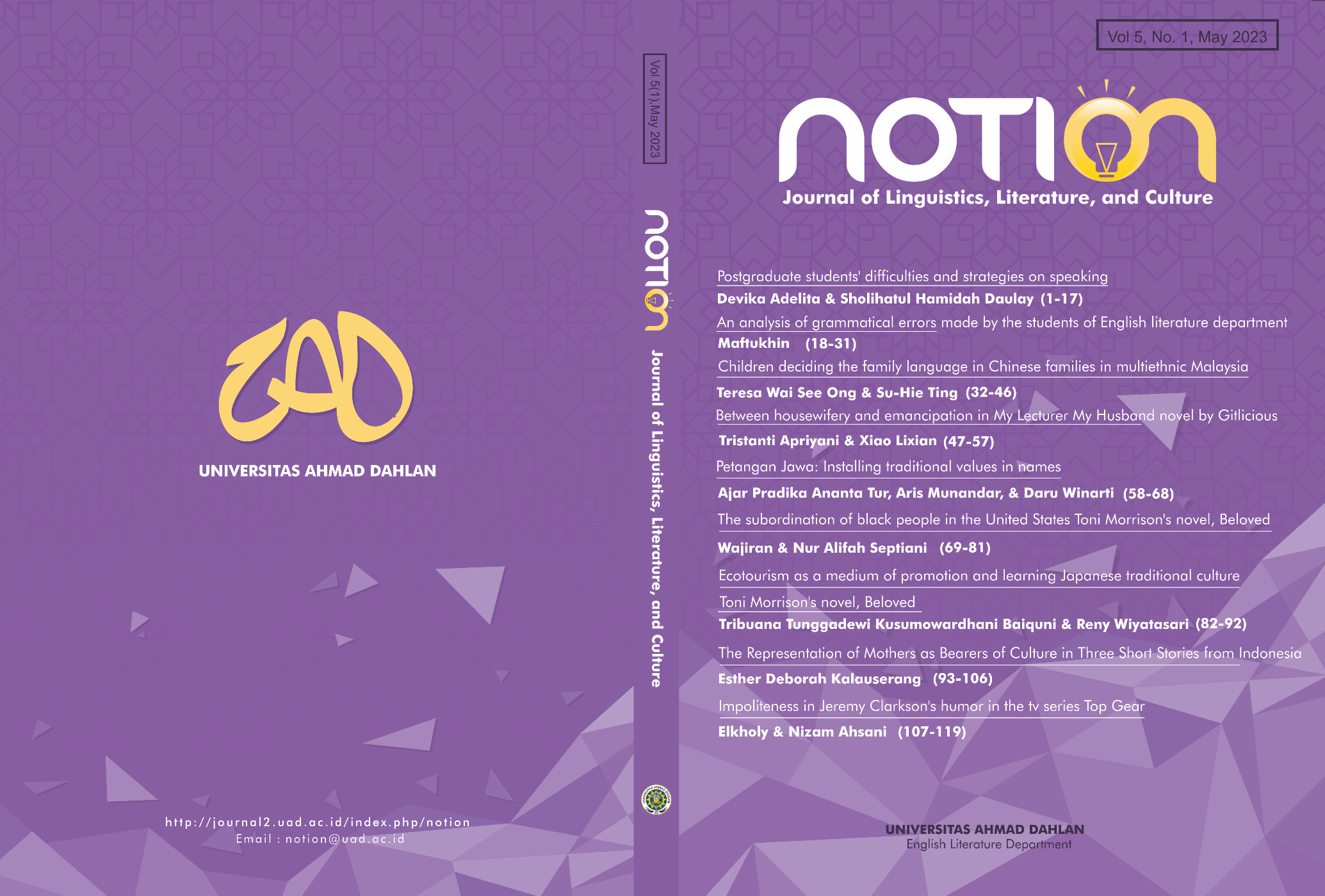Petangan Jawa: Installing traditional values in names
DOI:
https://doi.org/10.12928/notion.v5i1.6891Keywords:
petangan Jawa, Javanese tradition, prajurit karaton yogyakarta, naming practiceAbstract
This research contributes to investigate a cultural continuity, particularly naming practice, in a homogenous Javanese community installing Petangan Jawa (Javanese Calculations). However, common Javanese slowly ignore it. This study employs a descriptive qualitative approach with fieldwork to investigate the intention behind the name. Therefore, two varieties of Petangan Jawa, namely, a calculation based on calendar properties and a calculation based on Javanese script values, are still consistently used. In addition, this study paves the way for future research on the causes of the gradual abandonment of Petangan Jawa among common Javanese and how the perspective of religious beliefs about Petangan Jawa is used to predict the future.
References
Alfan, M. (2017). Perjumpaan mistisme Jawa dengan Islam. Syifa al-Qulub, Vol. 2(1), pp. 44-55. https://www.academia.edu/37435254/PERJUMPAAN_MISTISME_JAWA_DENGAN_ISLAM
Aribowo, E. K. (2017). Linking Arabic, Islam, and economy: Onomastics on business name of people of Arab descent in Indonesia. Karsa: Journal of Social and Islamic Culture, Vol 25(2), pp. 284-306. http://ejournal.iainmadura.ac.id/index.php/karsa/article/view/1390
Aribowo, E. K., & Herawati, N. (2016). Trends in naming system on Javanese society: A shift from Javanese to Arabic. Lingua Cultura, Vol. 10(2), pp. 117-122. http://dx.doi.org/10.21512/lc.v10i2.1730
Azhari, S. & Ibrahim, I. A. (2008). Kalender Jawa Islam: Memadukan tradisi dan tuntutan syar'i. Jurnal Asy-Syir’ah, Vol 42(1), pp. 131-147. http://asy-syirah.uin-suka.com/index.php/AS/article/view/254/194
Coates, R. (2012). Eight issues in pragmatic theory of properhood. Acta Linguistica Lithuania, Vol. 66, pp. 119-140. https://journals.lki.lt/actalinguisticalithuanica/article/view/994/1084
Cresswell, J. W. (2014). Research design: Qualitative, quantitative, and mixed methods approaches, (4th ed.). California: SAGE Publications, Inc.
Fitria & Tur, A.P.A. (2019). From Abstract to Concrete: Associating the Users’ Tweets on “Success”. Indonesian Journal of EFL and Linguistics, Vol. 4(2), p. 121-134. https://pdfs.semanticscholar.org/3af5/b3f2fe46421b4da5819ccb6c799aa9d9f6fa.pdf
Karkono, Maulida, J., Rahmadiyanti, P. S. (2020). Budaya patriarki dalam film Kartini (2017) karya Hanung Bramantyo. Kawruh: Journal of Language Education, Literature, and Local Culture, Vol. 2(1), pp. 15-27. http://journal.univetbantara.ac.id/index.php/kawruh/article/view/651
Marsono. (2011). Morfologi bahasa Indonesia dan nusantara (Morfologi tujuh bahasa anggota rumpun Austronesia dalam perbandingan). Yogyakarta: Gadjah Mada University Press.
Masruhan. (2017). Islamic effect on calendar of Javanese community. Al Mizan: Jurnal Pemikiran Hukum Islam, Vol. 13(1), pp. 53-68. http://journal.iaingorontalo.ac.id/index.php/am/article/view/732/695
Radjiman. (2001). Konsep petangan jawa. Semarang: Pustaka Cakra.
Tjahyadi, S. & Anshori, M. (1996). “Petangan" dalam kosmologi Jawa di tengah pluralitas pandangan dunia: Sebuah kajian sosiologi pengetahuan tentang tradisi dan perubahan "minoritas kognitif". Jurnal Filsafat, Seri 25, pp. 15-22. https://jurnal.ugm.ac.id/wisdom/article/view/31629/19164
Tur, A.P.A. (2019). Patterns of linguistics features in private chat of social media account leading a person to be a victim of a cybercrime. LEKSIKA, Vol. 13(1), p. 29-38. https://jurnalnasional.ump.ac.id/index.php/LEKSIKA/article/view/3858/2423
Tur, A.P.A. (2022). Trend of having more name parts in homogenous community. BAHASTRA, Vol. 42(1), p. 17-25. http://journal1.uad.ac.id/index.php/BAHASTRA/article/view/66/18
Widodo, S. T. & Saddhono, K. (2012). Petangan tradition in Javanese personal naming practice: An ethnoliguistic study. GEMA Online: Journal of Language Studies, Vol. 12(4), pp. 1165-1177. https://ejournal.ukm.my/gema/article/viewFile/1575/1362
Downloads
Published
Issue
Section
License
Copyright (c) 2023 Ajar Pradika Ananta Tur, Aris Munandar, Daru Winarti

This work is licensed under a Creative Commons Attribution 4.0 International License.
Authors who publish their articles in NOTION: journal of Linguistics, Literature, and Culture agree to the following terms:
- Authors retain the copyright and grant the journal right of first publication with the work simultaneously licensed under a Creative Commons Attribution 4.0 International License that allows others to share the work with an acknowledgement of the work's authorship and initial publication in this journal.
- Authors are able to enter into separate, additional contractual arrangements for the non-exclusive distribution of the journal's published version of the work (e.g., post it to an institutional repository or publish it in a book), with an acknowledgement of its initial publication in this journal.
- Authors are permitted and encouraged to post their work online (e.g., in institutional repositories or on their website) prior to and during the submission process, as it can lead to productive exchanges, as well as earlier and greater citation of published work.





